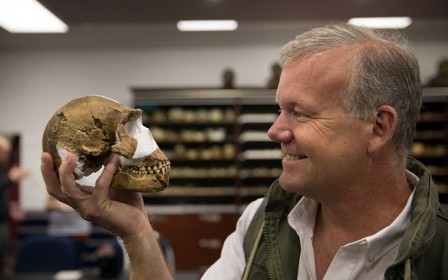New species of human ancestor discovered
Johannesburg
A trove of bones hidden deep within a South African cave represents a new species of human ancestor, scientists announced yesterday in the journal eLife. Homo naledi, as they call it, appears very primitive in some respects—it had a tiny brain, for instance, and apelike shoulders for climbing. But in other ways it looks remarkably like modern humans. When did it live? Where does it fit in the human family tree? And how did its bones get into the deepest hidden chamber of the cave—could such a primitive creature have been disposing of its dead intentionally?
This is the story of one of the greatest fossil discoveries of the past half century, and of what it might mean for our understanding of human evolution.
The new species has been identified from the fossilised bones of at least 15 individuals who were ritually buried deep underground in a South African cave many thousands of years ago.
The species has anatomical similarities to modern-day humans,such as feet designed for long-distance walking, but also bears ape-like characteristics such as narrow shoulders and curved fingers for climbing.
Although the species, named Homo naledi after the cave where it was found, had a brain no bigger than an orange scientists believe it must have buried its dead in a ritualistic manner, which is one of the key hallmarks of being human.
The diminutive humans, who grew no bigger than about 5ft (1.5m) tall and weighed no more than about 7 stones (45kg), represent a new species belonging to the Homo genus because of their similarities to other humans but with unique features which set them apart as a distinct entity, scientists said.
The international team of researchers has found so many bones - more than 1,550 fossil fragments so far - in the cave’s deep chamber that they have multiple examples of practically every bone in H. naledi’s body, making it a unique and important discovery in early human origins.
“The hands suggest tool-using capabilities. Surprisingly, H. naledi has extremely curved fingers, more curved than almost any other species of early hominins, which clearly demonstrates climbing abilities,” said Tracy Kivell of the University of Kent, who was part of the research team.
Yet the feet of these early humans, which are almost identical to those of modern man, combined with its relatively long legs reveal that the species was adapted to bipedal walking, said Professor Lee Berger of the University of Witwatersrand in Johannesburg, who led the expeditions that discovered and recovered the fossils.
“With almost every bone in the body represented multiple times, Homo naledi is already practically the best-known member of our lineage,” Professor Berger said.
“The combination of anatomical features in H. naledi distinguishes it from any previous known species,” he said.
The studies of H. naledi, published in the on-line journal eLife, concluded that the rich collection of bones buried deep in the cave - with many more still to be recovered - could have only got their by deliberate burial over many years.
Details of the find were revealed yesterday at a press briefing in Johannesburg.
Related Posts

